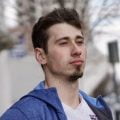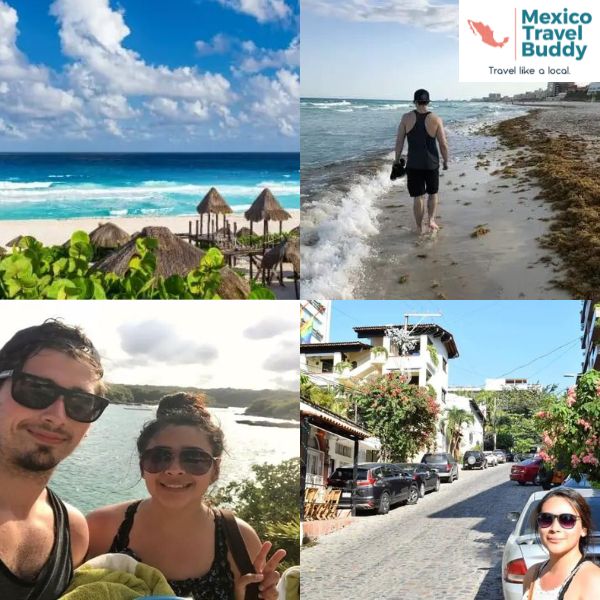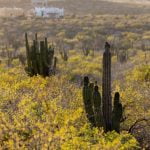I have always wanted to travel to Mexico with my dog, but I was curious what it actually takes to get them there. So, I did some in-depth research and here is what I discovered.
What You Need In Order To Travel To Mexico With Your Dog
In order to travel to Mexico with your dog, a health certificate is no longer needed. However, your dog needs to be in a clean, approved carrier, and you will need to visit the Mexican Animal and Plant Health Inspection Office (OISA) to contact the appropriate employee working with SENASICA. The office worker will check for the following on your dog:
- Your dog does not show signs of infectious and contagious diseases
- Your dog is free of ectoparasites (ticks and fleas)
- Your dog is free of any open and healing wounds
If your dog does happen to have parasites, you will need to contact a veterinarian to receive the appropriate treatment. If ticks are detected, the employee will take a sample of the ectoparasite, and send it off to the official laboratory for further testing. As well, they will verify that all parasites are removed from your dog.
Your dog will have to be kept at the OISA official Mexican office until the lab concludes the parasites are not foreign to Mexico. If so, SENASICA ultimately decides what steps to take next. Any expenses that may arise such as veterinarian costs, are expected to be paid by you (the importer).
If your dog is currently going through treatment for lesions or infections on the skin, you must bring a Veterinarian’s results and treatment in letterhead, along with their professional registration number.
It’s very important that the carrier your dog arrives in, is clean. Anything that is inside the carrier will be tossed out. If your dog has a favorite toy, don’t put it in there. A disinfectant will will be applied on your carrier, but this is expected.
NOTE: If traveling to Mexico with your dog on an airplane, airlines may have their own policies and requirements that you will need to adhere to; separate from your destination requirements.
Bringing Your Dog’s Food To Mexico
As far as bringing your dog’s food to Mexico, that a big no-no. You can only bring the amount of food your dog will eat on the day of arrival. Any additional food will be discarded.
Depending if you are heading to a large or small city in Mexico, they may or may not carry the brand of dog food your dog is use to eating.
If you are planning on staying in Mexico for at least a few weeks with your dog and you want to buy the correct dog food, just order it on Amazon.com and have it shipped to your location in Mexico.
The Cost To Fly Your Dog To Mexico
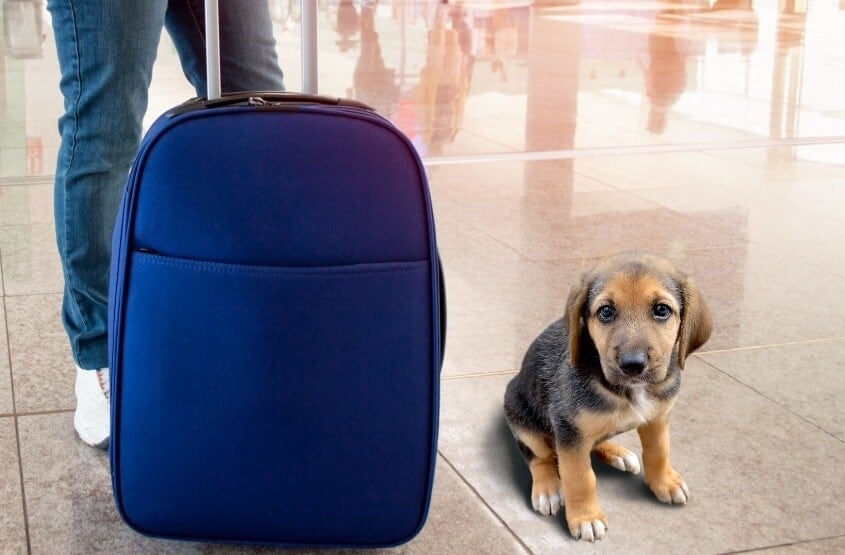
The average fee for a one-way flight to Mexico for your dog, ranges from $99 to $125. That does not include potential additional fees such as veterinarian costs; dog food, and an airline accepted pet crate, for a total ranging anywhere from $350 to $650 for a round-trip flight for your dog from the U.S. to Mexico.
These are rough estimates and greatly depend upon what you still need for your dog. If your dog is a registered service dog, the flight fee is usually waived, potentially saving you hundreds of dollars.
If you already have a pet crate that is acceptable for the airline you are flying with, then you save yourself another $50 to $150. So you may end up only spending money on your dog’s food and veterinarian costs, which can range from $50 to $100.
See also: Mexico Travel Insurance: Is It Worth It
However, if you’re anything like me and you still have to purchase everything for your dog before your flight to Mexico; expect to spend closer to the $500 to $600 mark for a round-trip flight for your dog.
Flying To Mexico With Your Dog
If you are trying to get to Mexico with your dog via airplane, this may require some additional documents and fees (ranging from $99 to $125 each way). Some airlines may require that your dog has a health certificate from a certified veterinarian to ensure that your dog is in good condition for flying.
Here is a list of airlines that currently allow dogs to fly internationally to Mexico, and which ones require a health certificate:
| Airline | Require A Health Certificate For Dogs | Fee For One Way Flight To Mexico (Service Dogs Fly Free) |
|---|---|---|
| AeroMexico | YES (Valid for up to 5 days from date issued) | $125 |
| American Airlines | NO | $125 |
| Frontier | NO | $99 |
| JetBlue | NO | $125 |
| Spirit | NO | $110 (Dogs not allowed on international flight unless they are a service animal) |
| United | Yes (Valid for 10 days from date issued) | $125 |
Flying With Your Dog In-Cabin

Many airlines will allow your dog to travel with you in-cabin however; there are strict requirements enforced by each airline.
Some things to take into consideration when flying with your dog in-cabin are your dog’s weight, the weight and type of carrier your dog is in, and the age of your dog (must be at least 16 weeks old for international flights to Mexico).
Here is the maximum weight and required carrier size for each airline:
| Airline | Maximum Combined Weight of Dog and Carrier | Required Carrier Type & Dimensions (L x W x H) |
|---|---|---|
| AeroMexico | 9 kg (20 lbs) | Only Soft-Sided Carriers (Check Prices) (16 x 12 x 8 in) |
| American | No specified weight limit (must be able to fit under seat) | Non-Collapsable & Soft-Sided Carriers (waterproof bottom) (Check Prices) (19 x 13 x 9 in) |
| Frontier | No specified weight limit (must be able to fit under seat) | Non-Collapsable & Soft-Sided Carriers (waterproof bottom) (Check Prices) (18 x 14 x 8 in) |
| JetBlue | 9 kg (20 lbs) | Non-Collapsable & Soft-Sided Carriers (waterproof bottom) (Check Prices) (17 x 12.5 x 8.5 in) |
| Spirit | 18 kg (40 lbs) | Only Soft-Sided Containers (Check Prices) (18 x 14 x 9 in) |
| United | No specified weight limit (must be able to fit under seat) | Non-Collapsable (17.5 x 12 x 7.5 in) Soft-Sided Carriers: (Check Prices) (18 x 11 x 11 in) |
When flying with your dog in-cabin, your dog must remain in its carrier at all times. The kennel must remain at your feet, under the seat in front of you.
As well, you are not able to sit in an emergency exit row if you have your pet with you as a carry-on, so check your seating arrangement to make sure this in not the case.
Flying With A Large Dog To Mexico
If you are flying with a dog that is either too heavy or too large, or maybe even both, you should consider checking your dog in with the luggage.
Your dog will then be placed in the cargo area of the plane, securely strapped down in its carrier. You must have your dog in a solid carrier that is approved for air transportation, each airline have their own requirements and limitations.
Here is a chart stating what each airline’s requirements and limitations are for checking your oversized dog in as luggage:
| Airline | Maximum Weight | Plane Type/ Combined Weight Of Dog And Carrier (L x W x H) |
|---|---|---|
| AeroMexico | (99 lbs) | (E-170 E-190) 40 x 36 x 32 in (B 737-700 and larger) 48 x 44 x 36 inches |
| American | No Specified Weight | (Larger Boeing) 48 x 32 x 35 in (Smaller Boeing) 36 x 24 x 26 in (Airbus) 27 x 20 x 19 in (Regional) 36 x 24 x 26 in |
| Frontier | N/A | Do not allow dogs to be checked as luggage |
| JetBlue | N/A | Do not allow dogs to be checked as luggage |
| Spirit | N/A | Do not allow dogs to be checked as luggage |
| United | No Specified Weight | (All United Aircraft) 36 x 25 x 27 in (All United mainline aircraft) 52 x 32 x 32.5 in |
If you need to check your dog in prior to your flight, it is recommended that you show up 3-4 hours before your departure, this will allow you enough time to get everything squared away.
Is It Safe For Your Dog To Fly In Cargo
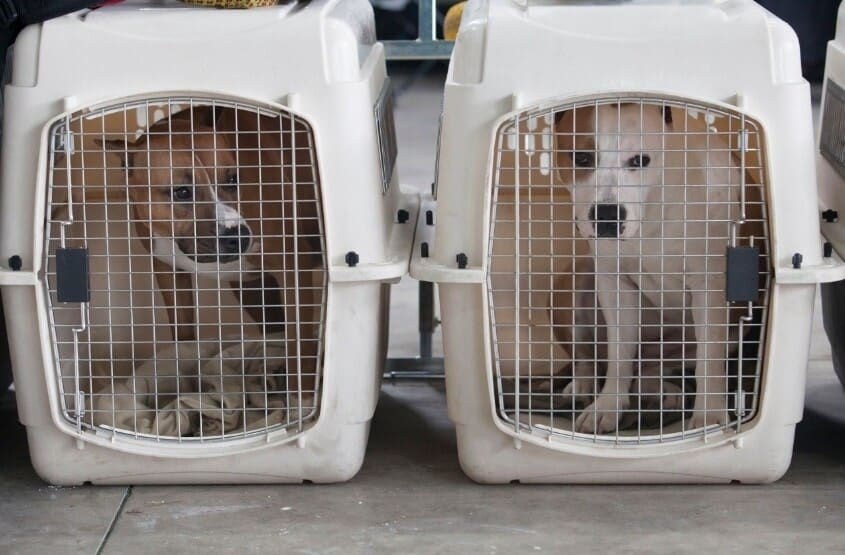
Overall, it is safe for your dog to fly in the cargo area of the plane. Your dog is required to be in a hard-shelled carrier with proper ventilation, which will be tied down to ensure minimal movement and sliding around.
Airlines will not load your dog in the cargo area if the temperature outside is lower than 45°F (7°C) or higher than 85°F (29°C) for safety reasons.
Make sure to go over this safety checklist, before checking your dog in with the cargo.
- Get a health checkup from a certified veterinarian 1-2 days prior to your flight
- Crate train your dog weeks prior; leading up to your flight
- Trim your dog’s nails before flying
- Ensure your dog has updated ID tags with your contact information
- Feed your dog 3-4 hours before your departure time; continue to give your dog water up until it’s time to checkin
- Try to book direct flights; avoid long layovers when possible
Getting a veterinarian to check your dogs health a couple days before travel is a good idea even if it not required by the airline. This way you can fly with a peace of mind, knowing your dog is in good health and has no pre existing medical conditions that may affect their flight experience.
While you are at the vet, make sure they trim your dog’s nails to help reduce the urge to scratch at their kennel during flight. Also, have your vet write up a proper feeding/water schedule for the day of the flight.
Moreover, it’s a good idea to crate train your dog, preferably in the same crate he will be flying in. This is especially true if your dog is not use to being locked up for longer periods of time in a kennel. I would start crate training at least 2 weeks prior to your flight date.
It’s important that your dog has proper identification with your current contact information attached to their collar, and even a tag on the crate isn’t a bad idea.
Although though your dog is required to be traveling on the same flight as you, this is good practice to ensure your dog reaches the destination safely and efficiently.
If at all possible, try to book your flight to Mexico direct from your original departure destination. If you can book your flight at a time of day where the temperature isn’t too hot 85°F (29°C) or too cold 45°F (7°C), this will ensure that your dog will be able to board the cargo area with no problems.
Generally, the longer your flight is and the more variances in climate change, the harder the flight will be for your dog.
Making sure to go over this pre flight checklist is very important to ensure your best friend is as comfortable and safe as can be on their flight to Mexico.
Flying To Mexico With A Service or Emotional Support Dog
When you are flying to Mexico with your service dog, airlines generally require the following:
- Registration letter/certificate for your service dog
- A medical health certificate from a certified physician; issued in letterhead stating you need to travel with your dog due to health issues (must have date issued, medical license number, and physician specialty license)
- A certificate of good health issued by a veterinarian (5 days from date issued) written on your vet’s letterhead with their license number. Letterhead must also include name and address of the owner; breed, gender, age, and color of the animal.
- Proof of rabies vaccination (no more than 3-years and no less than 30 days old) (dogs less than 3 months old are exempt)
If you are traveling to Mexico with your service dog, an advanced notice to your airline is encouraged but not required. However, if you are traveling with your emotional support dog, advanced notice and approval may be required before flights (provide notice at least 48 hours in advance).
Moreover, each airline will have different requirements when it comes to you and your service dog, so make sure to request everything that your airline will need well ahead of time.
| Ariline | Service/ Emotional Support Dog Requirements | Fee US$ |
|---|---|---|
| AeroMexico | View Requirements | EXEMPT |
| American | View Requirements | EXEMPT |
| Frontier | View Requirements | EXEMPT |
| JetBlue | View Requirements | EXEMPT |
| Spirit | View Requirements | EXEMPT |
| United | View Requirements | EXEMPT |
If your service dog is too large to fit below you, or under the seat in front of you, most airlines will allow your service dog to be seated next to you on a separate seat as long as it is not assigned to someone else; generally at no additional cost.
If your dog is too large to fit on the seat next to you, or in the event that no extra seats are available for your dog, you may have to purchase a plane ticket for your dog, rebook on a flight with more available seats or, transport your dog as a checked pet.
All these options will most likely include an additional fee, so make sure to contact your airline as soon as possible when flying to Mexico with your service dog.
Feeding Your Dog Before Your Flight
It is important to feed your dog 3-4 hours before your departure time. Avoid feeding your dog right before your flight; as your dog may experience an upset stomach. Most airlines require you attach a small bag of dog food to the top of the crate with feeding instructions for the day of your flight.
I’d also recommend two travel bowls for your dog that are attached to the inside of the crate. This will allow the staff to properly provide food and water per your instruction’s. Most airline approved dog crates will come with travel bowls when purchased such as this one found on Amazon. (View airline approved dog crate)
Traveling To Mexico With Your Dog Often

If you travel regularly between the U.S. and Mexico with your dog, you can request to register in the “Pet Program – Frequent Traveler”. The purpose of this free program is to speed up the process for people who travel frequently to Mexico with their dogs.
Here are some advantages of joining the Pet Program – Frequent Traveler:
- Reduce your waiting time
- No need to submit another Health Certificate during 6 months
- Data record will not be necessary (will already be in the database)
- No need to wait for a hard copy of the Import Certificate (will be emailed to you directly)
- “Entry Record” will be granted nationwide at the Office of Agriculture and Livestock Health Inspection (OISA) and at SENASICA’s headquarters
For further information please visit GOB.mx.
Coming Back From Mexico With Your Dog
When bringing your dog back from Mexico to the U.S, it must appear healthy, to enter. A rabies vaccination certificate is not required by the CDC when traveling back to the U.S. from Mexico (source).
There should be minimal fees when bringing your dog back to the U.S. from Mexico either by car or on a plane. However, the same requirements from your airline stay true, whether you are traveling to or from Mexico with your dog.
Driving To Mexico With Your Dog
As of December 16th, 2019 dogs no longer need a health certificate when traveling to Mexico. Upon arriving at the Mexican border, your dog may be physically inspected by SENASICA. Again, the inspector will verify the following:
- Your dog does not show signs of infectious and contagious diseases
- Your dog is free of ectoparasites (ticks and fleas)
- Your dog is free of any open and healing wounds
If your pup looks healthy, then you will be allowed entry into Mexico. One of the great things about driving to Mexico with your dog, is the fact that you don’t have to pay for the airlines fees or deal with the hassle of required dog crate dimensions.
Although, even if you are driving across the boarder, your dog still needs to arrive in a clean cage.
Remember, only bring the amount of food your dog is going to eat on the day you are traveling into Mexico. Any excess food will be thrown away upon entry into Mexico. You can purchase more food when your are in Mexico.
If you are staying at one location for a few weeks and want to order your dog’s specific food, you can most likely have it shipped directly to you from Amazon.
The Cost To Drive Your Dog To Mexico
The only expenses when driving your dog to Mexico will be the gas to get there, and a pet carrier (if you don’t have one). There are no additional fees for bringing your dog into Mexico by land from the U.S.
Be aware though, there are other expenses and documents that are required when driving a vehicle into Mexico, whether you have your dog with you or not. If you want to know exactly what you will need when driving to Mexico, you should checkout this blog: Traveling To Mexico By Car: Your Complete Guide.
Is It Safe To Bring Your Dog To Mexico
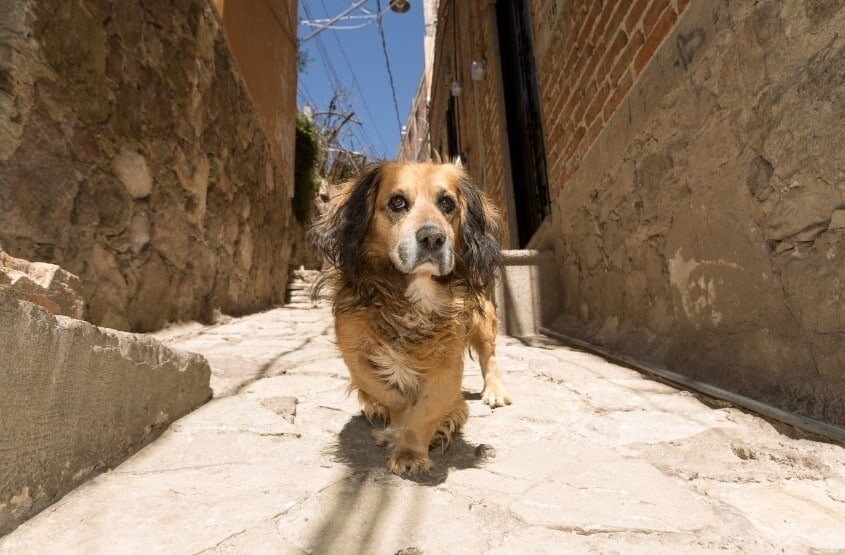
Overall, bringing your dog to Mexico with you is considered safe and a lot of people are doing it. Here are a few tips for keeping your dog safe when traveling around Mexico:
- Keep your dog hydrated
- Take your dog for walks early in the morning, or later in the day after the sun has set
- Avoid letting your dog eat trash and feces off the street
- Ensure your dog has a proper collar and updated ID tag containing your current contact info attached
- Try to feed your dog the same kind of food; don’t switch it up so often
- Avoid letting your dog mingle with any strays
Besides stating the obvious, your dog will most likely enjoy Mexico, just as much as you do.
Ultimately, if you are considering bringing your dog to Mexico with you, it will require some planning. But in my opinion, it is well worth it. I’ve noticed that a majority of people bring their dog to Mexico when vacationing.
After all, who wants to leave their best friend back at home?





